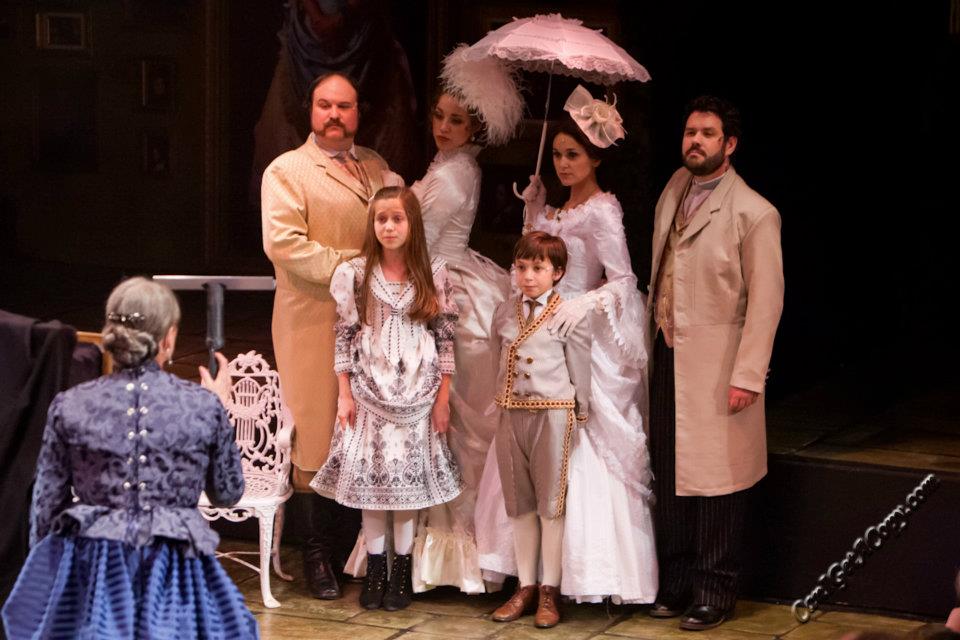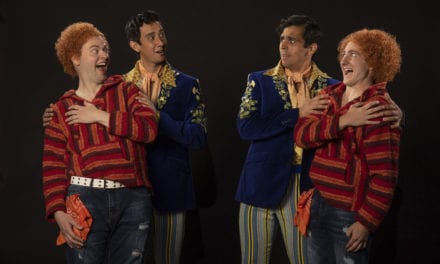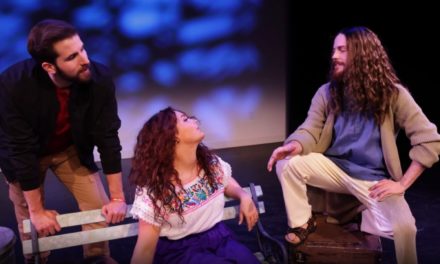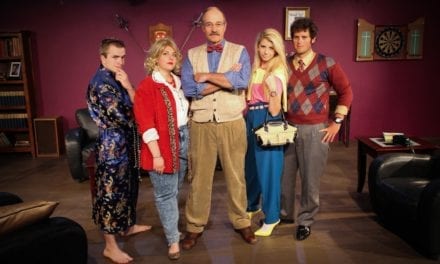SALT LAKE CITY — Westminster Opera Studio and Westminster Dance Company’s combined production of Henry Purcell’s Dido and Aeneas sparkles with young talent and creative staging, as directed by Opera Studio professor Emily Nelson and choreographed by dance professor Carly Schaub. With libretto by Nahum Tate, this opera standard was most likely composed in the summer of 1688, with its premiere performance at Josias Priest’s girls’ school in London by the end of 1689. It is considered one of the first English-language operas, and is the only opera composed by Purcell. The score performed on Sunday, April 27, 2025 at 4:00pm included all voice types, rather than an all-treble cast.
Ideal Venue
When I entered the Vieve Gore Concert Hall at Westminster University’s Performing Arts Center, I immediately noticed the diaphanous white curtains lit with interior lights which stretched nearly to the 20-foot ceilings; these set pieces created wing space and mood lighting for an otherwise plain recital stage, and were used in combination with projections to great effect during the action of the opera. Lighting is credited to Austin Ray, a student at Westminster University.
Although this hall usually hosts recitals and lectures, Nelson made a wise decision to utilize this space (rather than the black box theater next door) for an opera sung by young voices. The acoustics of Vieve Gore Concert Hall perfectly supported the developing Westminster Opera Studio students’ singing and highlighted the lighter timbre and faster decay of the strings, harpsichord, and theorbo featured in the Baroque chamber orchestra.
Sublime Direction
Emily Williams’ excellent music direction and conducting were evident in the sensitive and exciting playing from the orchestra, which included Williams herself at the harpsichord, Linda Duan on violin 1, Donni Evans on violin 2, Mallory Todd on viola, John Lenti on theorbo, and Brittany Gardner on cello. Of particular delight was the informative and comedic mini-lecture given before the performance by Lenti as he tuned his theorbo—which, if you were wondering, is the largest member of the lute family, was invented on the heels of opera itself, and includes two sets of strings, the higher of which are strummed like a guitar and the lower of which are tuned chromatically to amplify the bass frequencies used for dramatic purposes in opera scores.
Nelson’s wise directorial decisions didn’t end at the choice of performance venue. Dido and Aeneas has been accused of having a dreary plot—girl falls for boy before the opera begins; boy leaves girl; girl kills herself over his abandonment. But Nelson used the instrumental interludes to create new scenes between the title characters that gave development to Dido (acted beautifully by Kelln Pratt) and Aeneas’ (a strong sing by Chase White) relationship; we believed them to truly be in love as we watched them fall before our eyes accompanied by Purcell’s overture. These added scenes gave the audience stakes so that we cared about whether the lovers ended up together, and heightened the tragedy when the plot didn’t end happily ever after.
Another of Nelson’s choices to change the setting by having the Sorceress (a delightfully evil physicalization from Madeline Hansen) and her two witch minions (excellent singing and dancing from Stephanie Andrade as Witch 1 and Riley Allen as Witch 2) live under the sea also worked well to motivate the Sorceress’ machinations against Dido, which otherwise seem unfounded in the original libretto by Tate. In Nelson’s staging, it now made sense that the Sorceress would want to exterminate the human vermin who had so recently invaded her ocean paradise, and that she would go to any lengths to torture or kill their queen, including magicking one of her servants to look like the messenger god Mercury (sung with a pure tone by Michael Clark) to send Aeneas a false message that he must leave Dido immediately and thus ensuring Dido’s doom.
The one directing choice I felt didn’t fully translate was to have Dido’s famous aria “When I am Laid in Earth” result in her drowning in the sea. Although I enjoyed the choice to have Belinda pulled offstage by the Sorceress’ spirits so that Dido was left alone in this final moment, it did seem slightly odd that the aria mentions being buried in earth, only to have the singer swallowed up by the sea in front of our eyes. Thematically, though, I thought it was a satisfying full-circle moment, and the colorful costumes, scarves, and dance fabrics designed by Andrea Davenport added immensely to the scene’s effectiveness.
Performances
Of particular note in this performance were Eleanor Scoville as Belinda, Dido’s attendant and confidante; Tevarii Pecueux as First Sailor; Chloe Conti as Second Woman; Stephanie Andrade and Riley Allen as the Witches; the excellent chorus, comprised of Ashley Kalana, Diana Kelsch, Elliot Payne, and Colin Wyrsch; and the dance ensemble featuring Hannah Allen, Lucien Blanchard, Lillian Bramble, and Bella Sims.
I enjoyed Scoville’s bright, consistent tone which easily filled the space, and her sparkling stage personality lit up a plot which tends toward gloominess. Her Belinda was the perfect foil to the heaviness given to Dido in the score. In a similar way, Pecueux as the First Sailor gave us all a rollicking good time in one of the lighter scenes in the opera, and his acting physicality and strong vocal production were joys to experience.
Conti as Second Woman had a difficult task in that her duet with Belinda is not an easy sing and her character’s relationship is not set up clearly in the libretto, but she was more than up for the job! Her acting was grounded and authentic and her singing lovely.
Asking opera singers to dance while they sing is a tall order, and I was particularly impressed that Andrade and Allen, as the two Witches, never missed a beat in their coloratura duet while doing scarf work in their delightfully evil undersea scene. Brave!
The vocal and dance ensembles were also impressive in their own rites. The singers, prepared and conducted by Williams, were especially exciting in their off-stage finale. They sang with thrilling phrasing and dynamics, all while not even being able to see Williams’ conducting gesture, simply going by feel—an inspiring feat by any standard. The singing and dance ensembles were always engaged in the story whenever they were onstage, and I appreciated the energy they added to the story by centering on the principal singers and developing their individual characters without pulling focus. That’s one thing I always watch for in an opera, and these students more than delivered!
I particularly enjoyed the mask work from the dance ensemble in Act II’s portrayal of the story of Actaeon. Schaub’s choreography and story-telling, although strong for the entire opera, shone exceptionally brightly in this scene. Choreography for opera, especially in an educational setting, must walk a fine line of artistry, storytelling, and accessibility. The dance ensemble, prepared by Schaub, were excellent examples of each of these qualities.
Conclusion
In all, this production was full of smart creative choices that showcased the best things happening in Westminster University’s Opera Studio. Bravi tutti!
Editor’s Note: This review was written by Mandi Barrus of Opera Contempeo

These reviews are made possible by a grant from the Salt Lake County Zoo, Arts, and Parks program.





